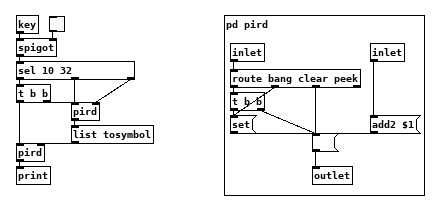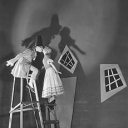Euclidean rhythms?
@jameslo said:
@atux Can you please repost the links to the two patches you tested? I'm particularly interested in the arithmetic of post #7 but can't make sense of the text representation of @Stutter's patch (and all the hurleur links are broken for me).
Ok, I see that I was preceded.... :D
I add @kyro's patch with matrices: euclidean.pd
I tested @Stutter's patch as subpatch.
For example, with the triad: 3,0,8 the rhythm is obtained:
TUM ta ta TUM ta ta TUM ta
Bye,
a.
Euclidean rhythms?
Thank you,
very interesting. Two completely different ways: a matricial approach and an apparently simple and effective algorithm.
Ok, the graphic part is missing (with clocks and inscribed geometries ...) to "visualize" the rhythms, but the engine that generates the Euclidean rhythms works perfectly.
I have tested both patches, they are great.
Bye,
a.
Euclidean rhythms?
Hi all,
I'm looking for a well done patch for midi Euclidean rhythms generation, with the possibility to vary steps, pulses and offset.
Thanks for any advice.
[I use Purr Data on Ubuntu 18.04]
a.
Signal logic - Clocks, Division and sequences
Expanded my pulse counter a bit: Dividing the pulse magnitudes, and then re-doing the edge detection works.
If the ratio is an integer, then it's more-or-less a classical modular pulse divider (though it assumes the pulses are single-sample, which [phasor~] --> {rzero~] --> multiply-and-clip does provide).
If the ratio is rational but non-integer, then you get sorta like Euclidean rhythms for free! (1.75 is producing ONE two THREE four FIVE six SEVEN ONE two ... I also tried dividing by 8/3 and got one of the standard Euclidean clave rhythms, One two three Four five six Seven eight One two three...)
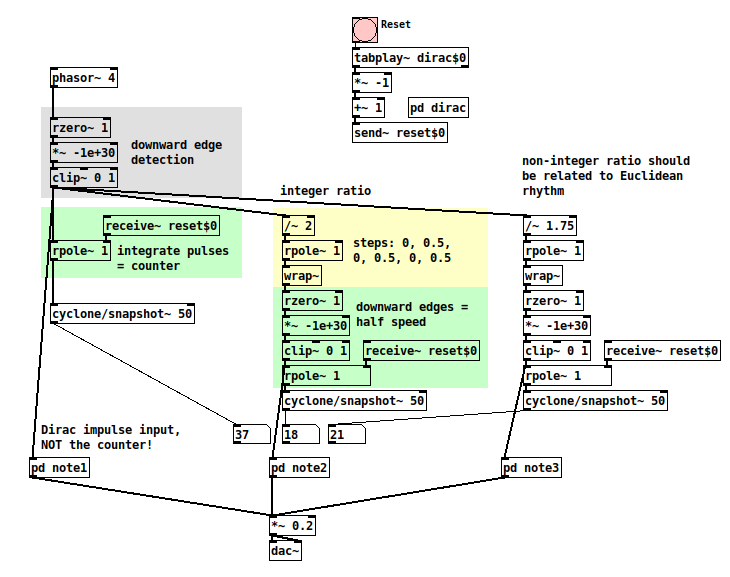
hjh
Keboard input to make up numbers & navigation
Might as well toss this here, a very simplified version of the horrifically complex key input processing for the project which will never end. It lets you get lists of symbols.
Edit: [list store] is probably better than [pird] for most peoples needs but [pird] will also be fine for most needs.
@radiowaves said:
Unfortunately never finished the graphical part, but hopefully will do it one day.
I have one of those as well, never could quite get polyrhythms to work with a reasonable ppq, screen would always start lagging. Always meant to try it with data structures to see if that would solve it but never got around to it.
How to send OSC messages to PdParty in Pd-vanilla?
Hi all,
I know this question has been asked on the forum a lot and I've been reading through the documentation, but I just can't seem to get things working and would greatly appreciate any help.
I'm using Pd to facilitate performance of polyrhythmic music, by having the players follow a visual metronome on their phones as they play. I've got the following patch Violoncelle.pd up and running on PdParty on my iPhone and would simply want to be able to control the number box "grille" and the toggle remotely from a patch on my computer.
Thanks in advance for any help!
Olivier
How to display a PD patch on smartphone?
Hi everyone,
I'm currently writing a piece for string quartet that simultaneously uses different metronome speeds to facilitate the execution of complex polyrhythms. In order to avoid using clicktracks, which, as a performer, I find very distracting, I've written a PD patch that acts like a visual metronome, with a slider and bang indicating the speed and number boxes counting the beats of the measure and the measure numbers, so the players don't get lost. All the speed changes are automated, so I only have to give it the initial bang, and the patch takes care of the rest.
I'm looking for a way to have the patch work on iPhone or Android, so that the players could use their phones as metronomes during the performance. There is no sound component to the patch, it's only meant as a performance aid. I could then have the players connect to a network and launch the patch with a netbang.
I've never used PD on smartphone before, and have found the documentation available on the internet a little confusing. I'm hoping that what I want to do might actually be pretty simple, so if anybody has any idea how to just display a patch on smartphone, I would be so grateful for your help.
Thanks in advance!
Olivier
Circular representation of intervallic structure/rythms
Hi, the request is for something like this where we can see the intervalic structure of a scale. This would also be good for graphing euclidean rythms. Anyone ever done that for Pd? I'm gonna have a go at it...
reference link an object from Open Music (n-cercle):
https://www.researchgate.net/figure/Circular-representation-intervallic-structure-and-rhythmic-interpretations-of-two_fig2_280757044
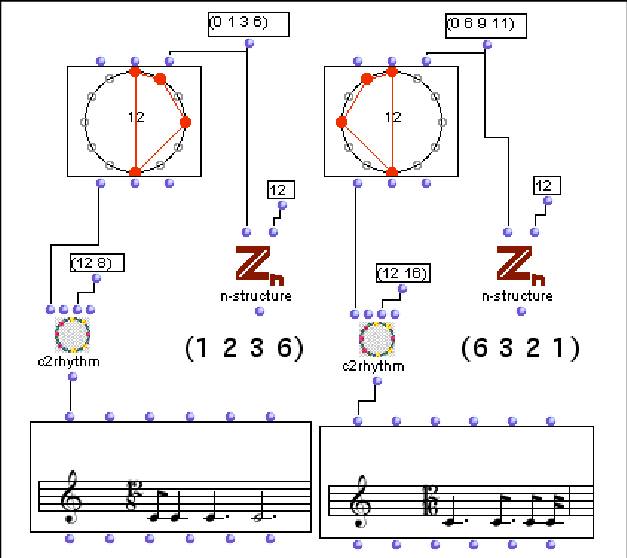
best way to get various rhythmic tuplets of a metronome tick, as accurate as possible.
@nicnut Possibly every two rhythms can have a common metro that counts to the least common multiple of the number of beats of each rhythm and each rhythm would just take the beat that is divisible by that number.
I made an attempt to build this. It actually just uses the product instead the least common multiple, so there is room for optimization.
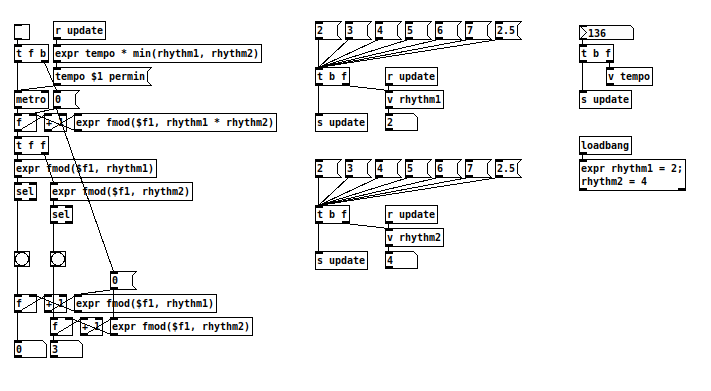
Here the number n of each rhythm means: Play at each nth beat of the common beat. That is why 2 is faster than 4.


